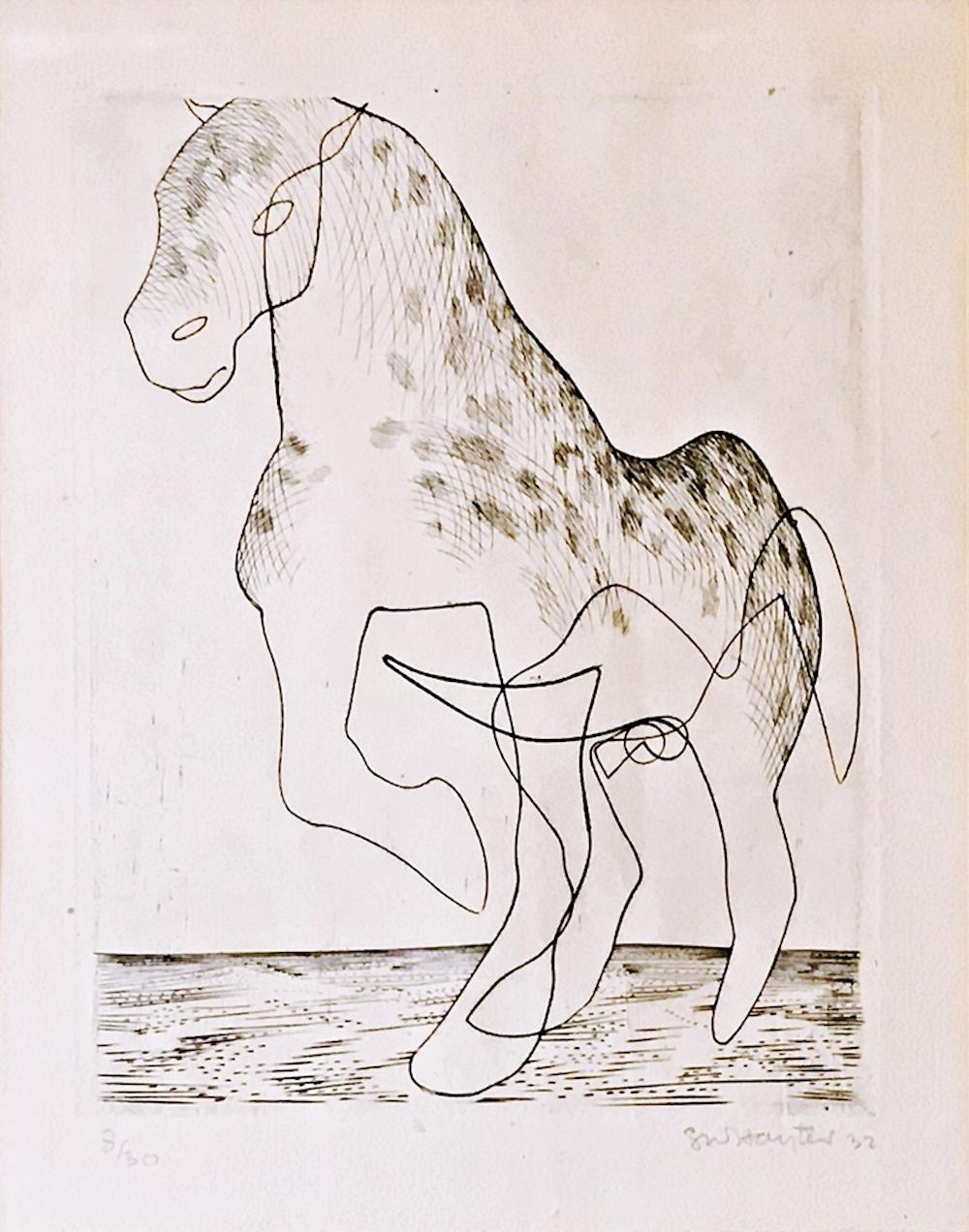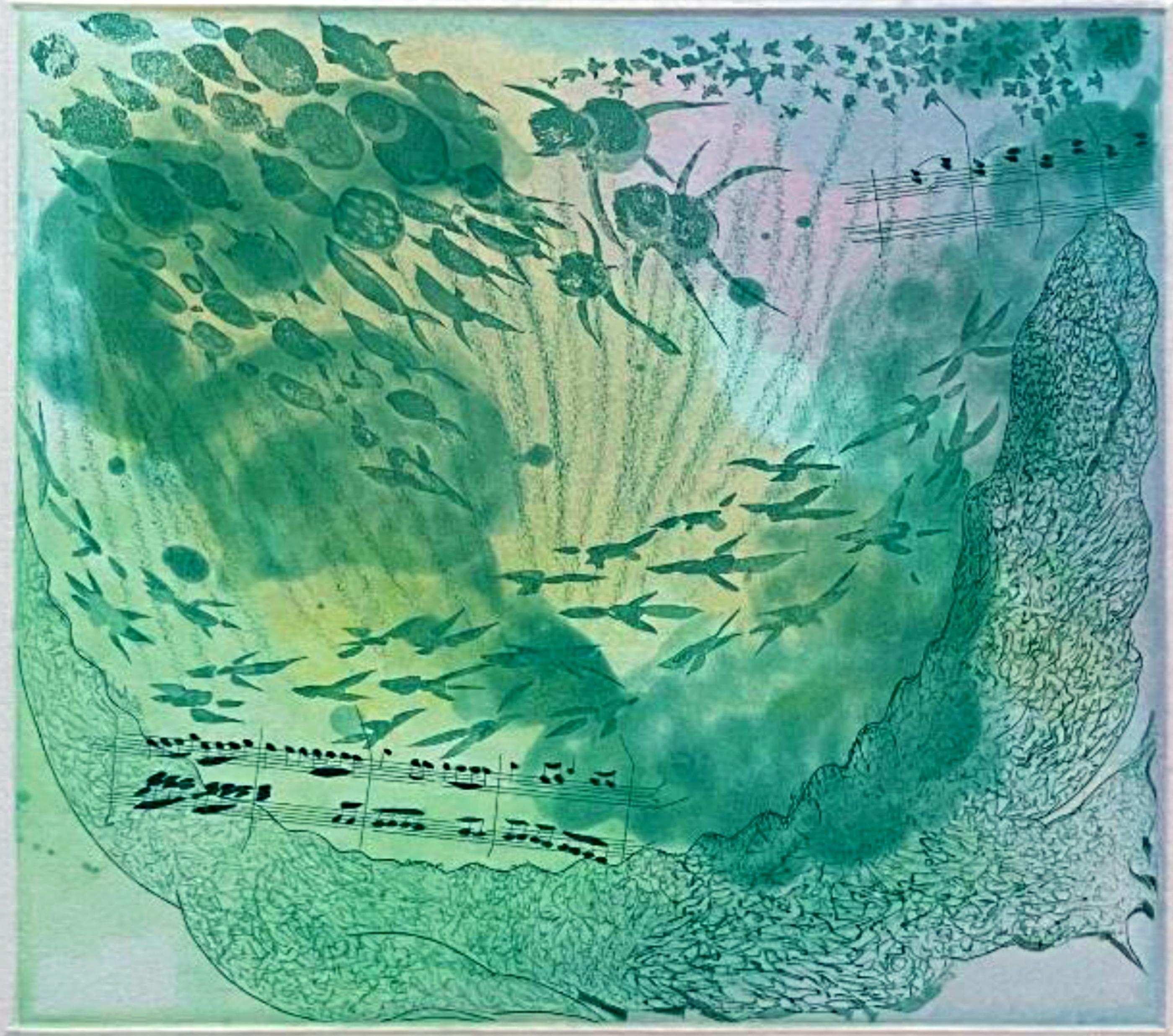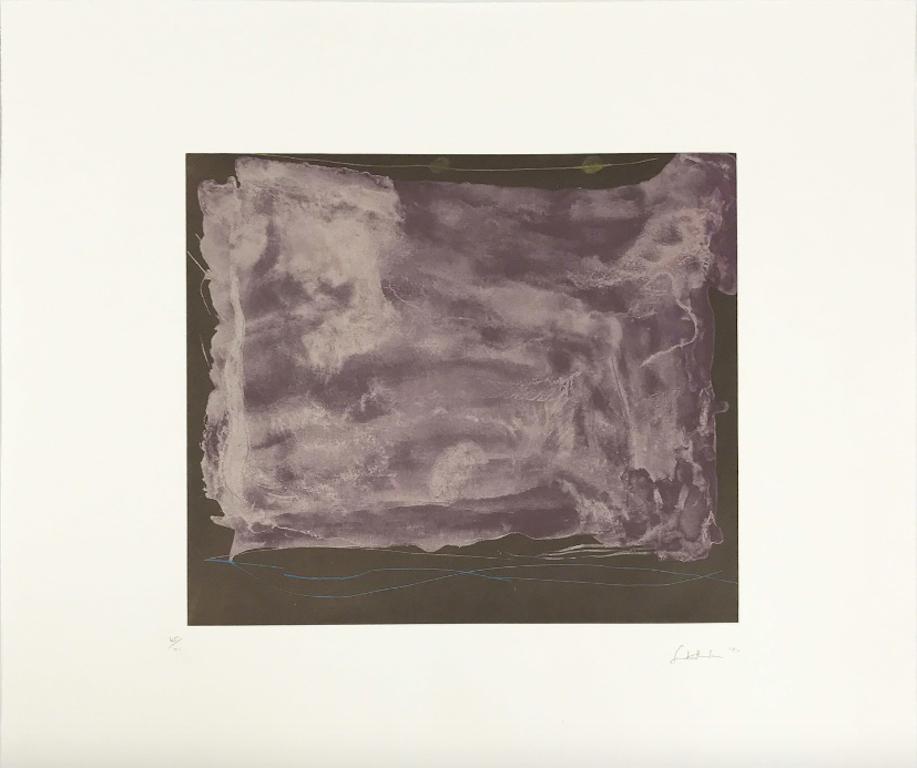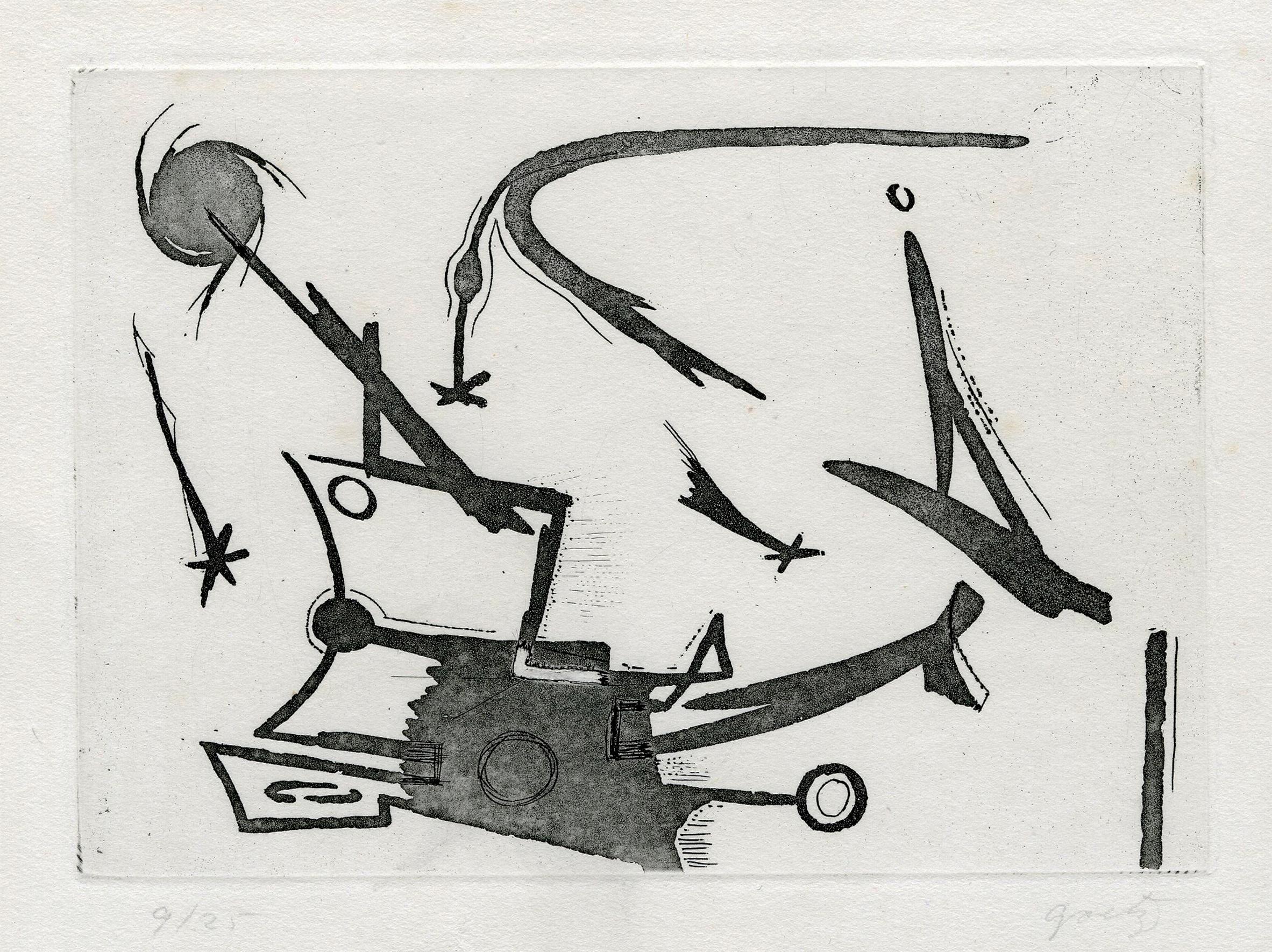Items Similar to Omar’s Cup
Want more images or videos?
Request additional images or videos from the seller
1 of 8
Bernard ChildsOmar’s Cup1958
1958
About the Item
Omar’s Cup
Power drypoint engraving, 1958
Printed in red, black with gold leaf highlights
Annotated in pencil on detached bottom margin: “Printed by the artist’s own press at 4 rue d’universite, Paris, Sept. 1958”
Signed and dated lower left: "Childs '58"
Edition: 10 (8/10)
Condition: Excellent
Plate: 7 3/4 x 4 1/4"
Sheet: 23 3/4 x 19 9/16"; (See photo)
Dedicated in pencil by the artist: “For Alice and Albert Turner”, Cincinnati, Ohio
Note: An impression of this image is in the collection of the Harvard Art Museums, M22802
Bernard Childs (1910-1985)
Bernard Childs (1910–1985) was an artist who worked in Paris and New York. He was primarily a painter and printmaker, and pioneered the direct engraving of metal plates with power tools. As a kind of counterpoint to his many-layered work, which is often symbolic and a fusion of abstraction and figuration, in 1959 he also started painting portraits. Childs' formal interests were line and space, light and color, and the dialogue of contrasting elements.
Life
Childs wrote, "My work is to make pictures." He first found his vocation in high school, in Harrisburg, Pennsylvania where his Russian immigrant parents had moved the family from his birthplace, Brooklyn. During her last days, his mother told him he was the seventh generation of artists in the family, his forebears having been painters of icons in the churches of Yaroslav.
In 1928, a scholarship took him to the University of Pennsylvania. He left two years later for New York where he worked by day and studied at night with Kimon Nicolaїdes at The Art Students League in New York. He also had the luck to meet the great Danish silversmith Peer Smed, from whom he learned his love of metal.
The economic and social problems of the 1930s took Childs away from his work as an artist, until he began drawing again in the South Pacific while serving as a quartermaster aboard the destroyer escort USS Wesson, during World War II. Childs survived a Kamikaze attack and, at war's end, two years of intermittent hospitalization after returning to New York. His recovery was complete by 1947, the year he studied with Amédée Ozenfant, who became a good friend. In 1951, thanks to the G.I. Bill, he sailed for Italy where he began his full-time life as an artist. It was there that he met and became friends with Alberto Burri and Enrico Baj.
Following a year in Perugia and in Rome and his first solo exhibition, at the venerable Galleria dell'Obellisco, Childs settled in Paris, realizing his first mature painting at age 42 and quickly becoming part of the European vanguard. He was included in many exhibitions of the Paris salons, various galleries such as Ariel and Iris Clert, Galerie Parnass in Wuppertal and the free floating group Phases along with Alechinsky, Baj, Cousins, Ernst, Fahlström, Fontana, Lam, Jaffe, Pederson, Soulages, Yasse Tabuchi, and Tajiri. He was championed by the French art critics Pierre Restany and Édouard Jaguer, and the Swedish art historian and curator Ragnar von Holten.
By 1959 he was in Documenta II and had his first solo museum exhibition, of paintings and prints, at the Stedelijk Museum in Amsterdam. It was in early 1955, after a month in December 1954 at Atelier 17, that he had signed his first editions of prints and begun pioneering the direct engraving of metal plates with power tools for which he is well recognized. Childs was also one of the first post World War II Western artists invited to show in Japan where he had two exhibitions, of paintings and of prints in 1960 and 1961 respectively at the Tokyo Gallery, and received the Museum of Western Art Award at the 1961 Tokyo International Print Biennial.
From 1966 to 1977, Childs commuted between his Paris studio and his New York studio at the Hotel Chelsea. In 1969, a retrospective of his 1960's paintings, prints and engraved acrylic light sculptures was held at the Storm King Art Center in Mountainville, NY. This exhibition was the occasion for the first public view of his light sculptures – laminates of engraved sheets of acrylic lit from below – an experiment with light and color that he began the same year and continued through part of the 1970s.[2] Although a stroke in 1978 interrupted his career, Childs never stopped drawing and soon resumed painting, remaining in New York until his death at age 74 in March 1985.
Although he exhibited extensively in group shows, Childs was essentially a loner. A renowned curator once called him a "rogue artist", one who cannot be defined by a category, a group, or a decade. Often a fusion of abstraction and figuration, at times paralleled by portraiture, his is a body of work rooted in the second half of the 20th century and whose ongoing appeal defies time.
Formal interests and underlying stories
Underlying Childs' art is a story of survival – of war, of environmental disaster – expressed with consummate craftsmanship and an ever renewed search and invention in many mediums. Ancient insect species became a favorite symbol of survival.[3] He drew their movements and strength up close and even sent them in his 1970's paintings to explore outer space for a new home, should planet Earth no longer support life. Survival of the planet and above all, survival of life in no matter what form it took, was a big concern. Creation myths, world myths, certain literary myths were close to his heart.
Childs' formal concerns were line and space, light and color, and the dialogue of contrasting elements related in time but often projecting different spatial environments. Portraiture and figuration of one kind or another are ever present, overtly or woven into abstractions. Childs took a sensual pleasure in his materials and a sensual, witty approach to many of the visual stories he told. His erotic stories of love are tender and sometimes funny. Danger is reflected in both his memories of war and his warnings of future dangers such as nuclear holocaust.
Selected public collections
• Bibliothèque nationale de France, Paris
• Ishibashi Foundation, Tokyo (formerly the Bridgestone Gallery)
• Brooklyn Museum, Brooklyn, New York
• Grey Art Gallery, New York University, New York
• Hood Museum of Art, Hanover, New Hampshire
• Israel Museum, Jerusalem
• Metropolitan Museum of Art, New York
• Museum of Fine Arts, Boston
• Moderna Museet, Stockholm
• National Portrait Gallery, Stockholm
• National Portrait Gallery, Washington, DC
• The National Museum of Western Art, Tokyo
• Princeton University Museum of Art, Princeton, New Jersey
• San Francisco Fine Arts Museums, Palace of the Legion of Honor, Achenbach Foundation for Graphic Arts
• Smith College Museum of Art & the Mortimer Rare Book Room, Northampton, Massachusetts
• Stedelijk Museum, Amsterdam
• The Hyde Collection, Glens Fall, New York
• The Library of Congress, Washington D.C.
• The Butler Institute of American Art, Youngstown, Ohio
• The Jane Voorhes Zimmerli Art Museum, Rutgers, New Brunswick, New Jersey
• Whitney Museum of American Art, New York
• Worcester Art Museum, Worcester, Massachusetts
• Yale University Art Museum, New Haven, Connecticut
• The Harvard Art Museums, Cambridge, Massachusetts
- Creator:Bernard Childs (1910 - 1985, American)
- Creation Year:1958
- Dimensions:Height: 7.75 in (19.69 cm)Width: 4.25 in (10.8 cm)
- Medium:
- Movement & Style:
- Period:
- Condition:Slight mat stain from previous framing, printers’ creases in very large margins.
- Gallery Location:Fairlawn, OH
- Reference Number:
About the Seller
5.0
Recognized Seller
These prestigious sellers are industry leaders and represent the highest echelon for item quality and design.
Platinum Seller
These expertly vetted sellers are 1stDibs' most experienced sellers and are rated highest by our customers.
Established in 1978
1stDibs seller since 2013
716 sales on 1stDibs
Typical response time: 1 hour
Associations
International Fine Print Dealers Association
- ShippingRetrieving quote...Ships From: Fairlawn, OH
- Return PolicyA return for this item may be initiated within 10 days of delivery.
More From This SellerView All
- UntitledBy Henri GoetzLocated in Fairlawn, OHUntitled Signed in pencil lower right (see photo) Edition: 25 (9/25) (see photo) Engraving, drypoint & carborundum Printed by the artist Condition: Excellent, slight residue on reverse Sheet: 9 7/8 x 12 3/4" Image/Plate: 5 x 7" Note: Goetz was born in the United States, moved to Paris and became a noted Surrealist artist and journalist of the surrealist movement. As a printmaker, Goetz invented carborundum printmaking in the 1960’s. In 1968, La gravure au carborundum, a treatise on carborundum printing, was published by the Maeght Gallery. It was prefaced by Joan Miró. Goetz created many abstract prints using this method. Other artists such as Antoni Clavé, Antoni Tàpies, and in particular Joan Miró, employed carborundum printing in their work. Henri Bernard Goetz (1909-1989) Henri Bernard Goetz was born 29 September 1909 in New York, in a family of French and American origin. He studied at Harvard University and the Grand Central Art School before moving to Paris in 1930 where he continued his studies at the Academies Julian and Academies Ozenfant in Montparnasse. After a brief return to the US in the early 1930’s he settled permanently in France, taking a Parisian studio next to Victor Brauner. With Brauner Goetz became involved with the Surrealist group and was soon a highly accomplished exponent. 1935 would be a year of major importance for Goetz: he exhibited for the first time at the Salon des Surindependants, he married the Dutch painter Christine Boumeester and he met Hans Hartung, who would become a close lifelong friend. In 1937 Goetz held his first solo show at Galerie Van Leer, Paris. During the war, having neglected to become naturalized French citizens, Goetz and Boumeester became illegal aliens and both worked in the resistance movement. They printed leaflets on a simple printing press and created posters to paste...Category
1960s Abstract Expressionist Abstract Prints
MaterialsDrypoint, Etching
- UntitledBy Henri GoetzLocated in Fairlawn, OHUntitled Engraving, drypoint & carborundum, c. 1960's Signed and numbered in pencil (see photos) Edition: 25 (9/25) Printed by the artist Condition: Adhesive residue on the verso to...Category
1960s Abstract Expressionist Abstract Prints
MaterialsEngraving
- UntitledBy Henri GoetzLocated in Fairlawn, OHUntitled Engraving, drypoint & carborundum, c. 1960's Signed and numbered in pencil lower margin (see photos) Edition: 25 (9/25) Printed by the artist Condition: Adhesive residue on the verso top margin from previous matting. Image/Plate size: 4 1/2 x 4 inches Note: Goetz was born in the United States, moved to Paris and became a noted Surrealist artist and journalist of the surrealist movement. As a printmaker, Goetz invented carborundum printmaking in the 1960’s. In 1968, La gravure au carborundum, a treatise on carborundum printing, was published by the Maeght Gallery. It was prefaced by Joan Miró. Goetz created many abstract prints using this method. Other artists such as Antoni Clavé, Antoni Tàpies, and in particular Joan Miró, employed carborundum printing in their work. Henri Bernard Goetz (1909-1989) Henri Bernard Goetz was born 29 September 1909 in New York, in a family of French and American origin. He studied at Harvard University and the Grand Central Art School before moving to Paris in 1930 where he continued his studies at the Academies Julian and Academies Ozenfant in Montparnasse. After a brief return to the US in the early 1930’s he settled permanently in France, taking a Parisian studio next to Victor Brauner. With Brauner Goetz became involved with the Surrealist group and was soon a highly accomplished exponent. 1935 would be a year of major importance for Goetz: he exhibited for the first time at the Salon des Surindependants, he married the Dutch painter Christine Boumeester and he met Hans Hartung, who would become a close lifelong friend. In 1937 Goetz held his first solo show at Galerie Van Leer, Paris. During the war, having neglected to become naturalized French citizens, Goetz and Boumeester became illegal aliens and both worked in the resistance movement. They printed leaflets on a simple printing press and created posters to paste...Category
1960s Abstract Expressionist Abstract Prints
MaterialsEngraving
- Trees (Trees in Circle)By Louise NevelsonLocated in Fairlawn, OHTrees (Trees in Circle) Etching & drypoint with monotype inking, 1953-1955 Signed in pencil An unrecorded trial proof, printed on heavy wove proofing paper at Atelier 17, before the ...Category
1950s Abstract Landscape Prints
MaterialsDrypoint, Etching, Monotype
- Red MountainBy Louisa ChaseLocated in Fairlawn, OHRed Mountain Three color lithograph, 1986-7 Signed, titled and dated in pencil lower right Annotated "B.A.T." for Bon a Tire lower left corner This example is the printers guide for printing the editon of 40 Printed on BFK Rives paper Printed at Derriere L'Etoile Studios, New York Printer: Maurice Sanchez Condition: Excellent, never framed Image/Sheet size: 45 1/4 x 30 inches Louisa Chase came to prominence in the 1980's as one of the outstandingNeo-Expressionist painters. Her work then was characterized by bold colors and brush strokes, often incorporating natural elements and fragments of the figure. Louisa Chase's works have been featured in gallery and museum shows in Cologne, Nurnberg, Luzem, Switzerland, Toronto, and Tokyo, and various galleries and museums throughout the US. She has also been featured at the American Pavillion at the 1984 Venice Biennale. Also in 1984, the Institute of Contemporary Art in Boston organized as travelling exhibition of her work. In 1997, the Madison Art Center organized a retrospective of her prints, Louisa Chase: Prints, 1981-1996. She has been a featured artist at the University of Wisconsin's Tandem Press and at the Tamarind Press; ahe was also invited to do a print for Lincoln Center in New York City. The recipient of two grants from the National Endowment for the Arts, Chase's works are in the permanent collections of such museum as The Museum of Modern Art, the Metropolitan Museum of Art, The Whitney Museum of American Art (New York), The Brooklyn Museum of Arts, The Corcoran Gallery and The Library of Congress (Washington D.C.), The Walker Art Center (Minneapolis), the Mount Holyoke College Art Museum, the Denver Museum of Art, and the Chazin Museum of Art of the University of Wisconsin, Madsion and the Madison Museum of Contemporary Art (Madison WI). Bibliography: Elizabeth Armstrong, Painters who print (Minnapolis: Walker Art Center, 1984); Ruth S...Category
1980s Abstract Expressionist Abstract Prints
MaterialsLithograph
- Baby, BabyBy Louisa ChaseLocated in Fairlawn, OHBaby, Baby Etching & aquatint printed in colors, 1991 Signed, dated, titled & numbered in pencil (see photos) Edition: 35 (4/35) plus 10 AP Condition: Excellent, colors fresh Image...Category
1990s Abstract Expressionist Abstract Prints
MaterialsAquatint
You May Also Like
- Triptych of Three Monumental Etchings by Mimmo PaladinoBy Mimmo PaladinoLocated in Long Island City, NYA set of three monumental etchings by Italian contemporary artist, Mimmo Paladino. Each nicely framed in black. Artist: Mimmo Paladino Title: Si...Category
1990s Abstract Expressionist Abstract Prints
MaterialsGold Leaf
- Large Italian Aquatint Etching Francesco Clemente Neo Expressionist Avant GardeBy Francesco ClementeLocated in Surfside, FLFrancesco Clemente (Italian b. 1952), 'This side up / Telemone #2, 1981 Medium: Intaglio hard ground etching, color aquatint, drypoint, and soft-ground etching with chine collé (ha...Category
1980s Abstract Expressionist Abstract Prints
MaterialsDrypoint, Etching, Aquatint, Intaglio
- Big Horse (Black & Moorhead 46)By Stanley William HayterLocated in New York, NYStanley William Hayter Big Horse (Black & Moorhead 46), 1932 Engraving & Drypoint on antique white Canson Vidalon laid paper affixed to original matting Hand signed, numbered and dat...Category
1930s Abstract Expressionist Animal Prints
MaterialsEngraving, Drypoint
- Finale, from Carnival of Animals (Tyler Graphics, 119:SB31), mixed media FramedBy Stanley BoxerLocated in New York, NYStanley Boxer Finale, from Carnival of Animals (Tyler Graphics, 119:SB31), 1979 Etching, aquatint, engraving and drypoint on hand colored TGL handmade paper Edition 16/20 Pencil sign...Category
1970s Abstract Expressionist Abstract Prints
MaterialsEngraving, Drypoint, Etching, Aquatint, Mixed Media, Pencil, Graphite
- Soho DreamsBy Helen FrankenthalerLocated in New York, NY1987 Etching, aquatint and drypoint in colors, on wove paper Sheet: 15 3/4 x 18 3/4 in. Edition of 71 Signed, dated and numbered in pencil, lower marginCategory
1980s Abstract Expressionist Abstract Prints
MaterialsPaper, Drypoint, Etching, Aquatint
- Buoy Landscape IV, Mixed media signed/n limited edition Ab Ex relief printBy Sam GilliamLocated in New York, NYSam Gilliam Buoy Landscape IV, 1982 Color relief print, etching, screenprint, drypoint, aquatint and roulette all from deeply etched copper plates, on handmade wove paper 31 1/2 × 24 inches Hand signed and numbered 3/25 in graphite pencil Hand-signed by artist, Signed by artist, numbered, and dated in pencil and blind-stamped by printer-publisher on lower right, titled in pencil on lower left, recto Unframed with elegant deckled edges Rare vintage intaglio and relief, all from deeply etched copper plates. Other works from this series are in the permanent collections of major museums & institutions like the Smithsonian, so they are quite scarce on the open market. Steven M. Andersen (Printer) Philip Barber (Printer) Hang Nguyen (Printer) Stephanie Nowack (Printer) Michael Reid (Printer) Daniel Rounds (Printer) Vermillion Editions Limited (Publisher) Sam Gilliam Biography: Sam Gilliam was one of the great innovators in postwar American painting. He emerged from the Washington, D.C. scene in the mid 1960s with works that elaborated upon and disrupted the ethos of Color School painting. A series of formal breakthroughs would soon result in his canonical Drape paintings, which expanded upon the tenets of Abstract Expressionism in entirely new ways. Suspending stretcherless lengths of painted canvas from the walls or ceilings of exhibition spaces, Gilliam transformed his medium and the contexts in which it was viewed. As an artist in the nation’s capital at the height of the Civil Rights Movement, this was not merely an aesthetic proposition; it was a way of defining art’s role in a society undergoing dramatic change. Gilliam pursued a pioneering course in which experimentation was the only constant. Inspired by the improvisatory ethos of jazz, his lyrical abstractions took on an increasing variety of forms, moods, and materials. In addition to a traveling retrospective organized by the Corcoran Gallery of Art, Washington, D.C. in 2005, Sam Gilliam was the subject of solo exhibitions at the Museum of Modern Art, New York (1971); The Studio Museum in Harlem, New York (1982); Whitney Museum of American Art, Philip Morris Branch, New York (1993); J.B. Speed Memorial Museum, Louisville, Kentucky (1996); Phillips Collection, Washington, D.C. (2011); and Kunstmuseum Basel, Switzerland (2018), among many other institutions. A semi-permanent installation of Gilliam’s paintings opened at Dia:Beacon in August 2019. His work is included in over fifty public collections, including those of the Musée d’Art Moderne de la Ville de Paris; Tate Modern, London; the Museum of Modern Art, New York; the Metropolitan Museum of Art, New York; and the Art Institute of Chicago. Sam Gilliam, Green April, 1969, acrylic on canvas, 98 x 271 x 3 7/8 inches (248.9 x 688.3 x 9.8 cm), Collection of Kunstmuseum Basel, Basel, Switzerland, Courtesy of David Kordansky Gallery, Los Angeles, photography by Lee Thompson...Category
1980s Abstract Expressionist Abstract Prints
MaterialsMixed Media, Pencil, Graphite, Drypoint, Etching, Aquatint, Screen





